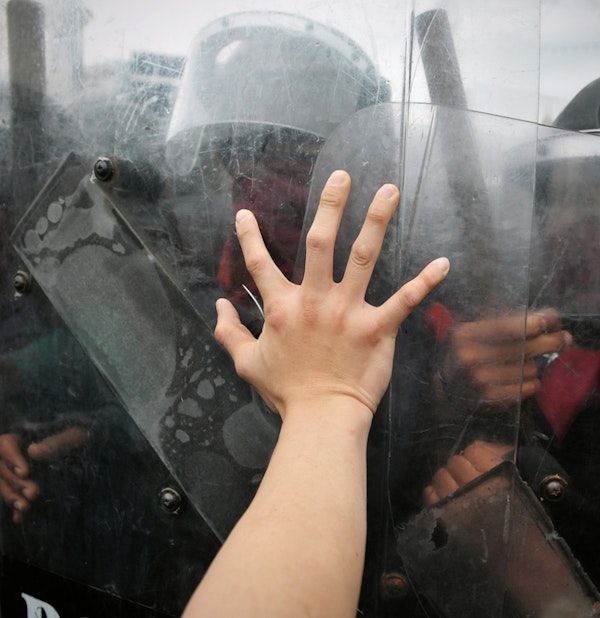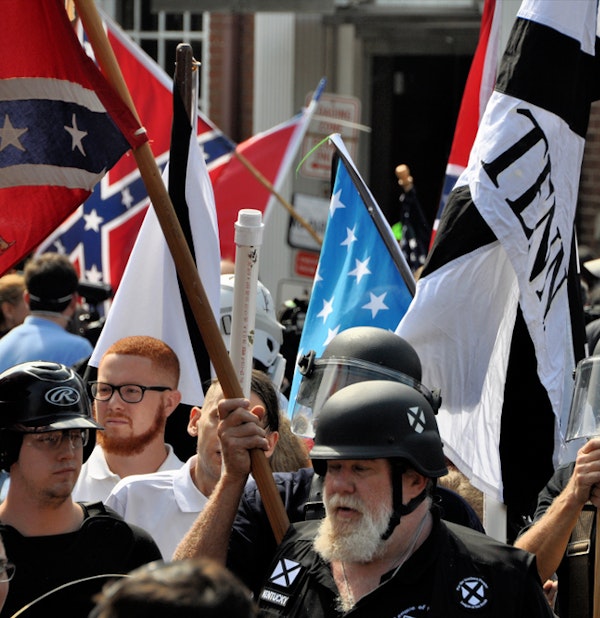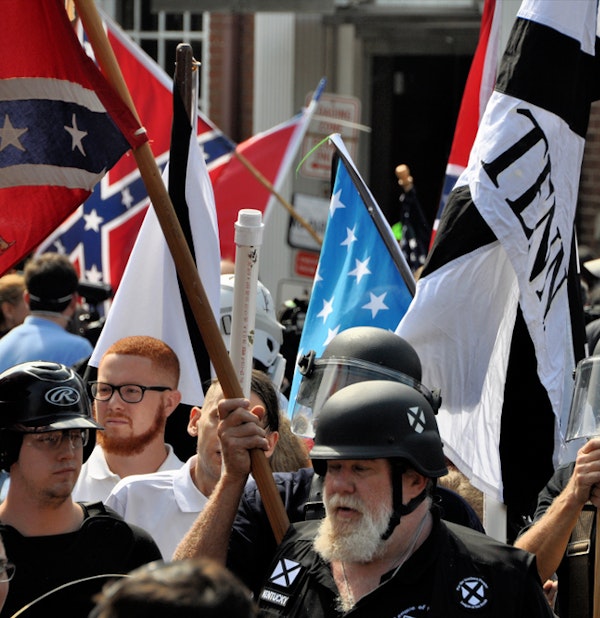Combating Political Violence
Political violence is rising across the world, including here in the United States. But proven strategies can help curb such violence, including domestic abuse and the acting out of ideological extremism.
 Protester pushes police riot shields at a political rally. (Photo via Shutterstock)
Protester pushes police riot shields at a political rally. (Photo via Shutterstock)
Rachel Kleinfeld is Senior Fellow at the Carnegie Endowment for International Peace. The Yale and Oxford graduate focuses her research on troubled democracies, particularly those beset by violence, corruption, and a declining trust in the rule of law. Time named her one of its 40 leaders under age 40 for her work in co-founding and directing the Truman Security Project. In 2021, her research into political violence in the United States appeared in the Journal of Democracy.
Kleinfeld participated in a Partnership for American Democracy event at the George W. Bush Institute in May. The New Mexico resident spoke then with The Catalyst about the threat of political violence in the United States, the effect of “stacking” identities, and the need for a healthier ideal of manhood. She also offered substantive suggestions for curbing political violence.
We know that extremism lives on the front pages, but so did it during the 1960s. How do radical activities, particularly political violence, differ today?
That’s a great question. People need to realize we’re in a position not dissimilar from the ‘60s in terms of the amount of political violence. But the nature of political violence is very different today.
In the ‘60s we had assassinations of presidents, presidential candidates, and leading activists. In the ‘60s and ‘70s, the groups using political violence were mostly on the left, organizations like the Weathermen and Symbionese Liberation Army. Then it started moving to the right with abortion clinic bombings and militias.
But in both cases, they were really fringe movements that were not connected to the political cycle. The people committing that kind of violence were in small cells and had removed themselves from the mainstream.
People need to realize we’re in a position not dissimilar from the ‘60s in terms of the amount of political violence. But the nature of political violence is very different today.
What we’re seeing now is different. We’re seeing violence moving from people in their 20s to people in their late 30s to 40s. They are settled, married with kids, and have jobs. Joining a militia or supporting violence is becoming more mainstream. You’re more likely to believe in conspiracy theoriesif you go to evangelical churches than if you don’t go to church. You’re more likely to be involved in some of these more extreme activities if you’re more involved in your community.
That’s worrisome. That’s what we see in other countries when violence begins becoming part of a political identity. Violence becomes another way of showing your politics and becoming accepted in a political sense.
 White nationalists and counter-protesters clash during a rally in Charlottesville in 2017. (Photo by Kim Kelley-Wagner/Shutterstock)
White nationalists and counter-protesters clash during a rally in Charlottesville in 2017. (Photo by Kim Kelley-Wagner/Shutterstock)
To what extent does political violence overseas have an effect here?
Transnational groups support one another and their ideas about violence. White nationalists and white supremacists have large international support networks. The Christchurch bombing in New Zealand resonated here in America, for example.
We also see Russia supporting political violence in democracies around the world. Russia puts out a lot of propaganda that is meant to just sow dissension. One way they do this in America is through race. They put out a lot of propaganda on Spanish language sites and in the U.S. They target information about African Americans and whites to create trouble.
The Russians have been very canny about funding individual groups, such as bikers and mixed martial arts groups, who are more willing to be aggressive. They’ve tried to do some of that in the U.S. It’s not proven how much they’ve done. But I wouldn’t be surprised if it’s more than we know because we know about a lot of this happening in Eastern Europe.
The Christchurch bombing in New Zealand resonated here in America, for example.
Your report talks about changes within extremist groups themselves, and how that might impact violence today. What do those changes look like? And how does that affect political violence?
Paradoxically, when you have small cells of people who know each other and are violent, you don’t have as much violence as you would in the less “grouped” situation today. If you’re in a militia with your brother, uncle, and neighbor, no one wants to get caught by the police. In those situations, people will turn on each other if they fear they will get caught. Or they may hold each other back, for instance, suggesting they just do something symbolic.
Now, we see people getting radicalized via the internet. They don’t necessarily join groups. In fact, more than half the people that are involved in violent activities are not in groups. They’re getting the ideology, but they’re not part of anything that can stop them. An example is the young man in Buffalo who killed 10 Black residents. There was no one to say, “You’re going too far and will be in jail the rest of your life.”
You also talked about hostility towards women being a factor in political violence. Could you elaborate upon what you see?
Three variables correlate with people who are more likely to commit violence. One is people who are aggressive in general – toward their kids, their animals, neighbors, co-workers. People with aggressive personalities tend to commit more violence.
We also find triggers from what’s called a racial hostility index. Do people feel like other races are getting ahead of the white race? And where do they fall on that scale? We find the racial hostility index has some correlation to violence.
White nationalists and white supremacists have large international support network.
The third is a gender hostility index. How hostile is someone toward women? The gender hostility index predicts violence the most. Men who feel dominated by women may be triggered by other things, such as racial or political issues, or memes they see online. Because their manhood feels threatened, they seem more willing to act on many triggers.
 White nationalists and counter protesters clash in during a rally. (Photo by Kim Kelley-Wagner/Shutterstock)
White nationalists and counter protesters clash in during a rally. (Photo by Kim Kelley-Wagner/Shutterstock)
Could you talk more about the role of identity in political violence?
American identities are stacking. It used to be that you could be a white man who was in a union, who maybe didn’t like minorities very much, but you were a Democrat because that union identity was very important to you, especially since you lived in the rural Midwest where there weren’t other job options. You had identities that were pretty mixed and overlapped with, say, a white man in the South who is Republican. We had cross-cutting identities where people could find more common ground.
Since the 2000s, we’ve seen a lot of sorting. If I know your political party, I can also probably guess your gender and race, where you shop, what sports you watch. All of these identities are stacking.
As a result, a trigger to any identity makes you feel defensive about all your identities. You have a much harder time finding common ground with other people because those you spend time with share all your identities. Those “other people” from the other party are more likely to also have a different gender, religion, race, and live in a different geography – they are from a totally different world. You can’t even talk about sports or TV shows, which are separated by party.
You have a much harder time finding common ground with other people because those you spend time with share all your identities.
With stacked identities, people are more likely to get defensive and feel like their group is being attacked because there is an attack on some part of your identity. And if you are an aggressive personality, you’re more likely to act out.
How do leaders or citizens get at those identity issues? Can cross-cutting ties be encouraged and developed to counter some of this?
Absolutely. There’s a carrot-and-stick approach here.
On the stick side, people have to be held accountable for violence. They just can’t do it. Our leaders need to say, “You can’t do this.”
On the carrot side, we have a lot of identities, right? I’m a woman, I’m also a mom of a seven-year-old and four-year-old. I share that with people who are different than me politically and racially, but we all share challenges of being moms or working moms. That’s another identity.
But we do too poor a job as a country of calling on those more complex identities and saying, “Where do we have connections? And how can we present ourselves in the richness of who we are?”
The media especially tries to present things as the Democrats won this, the Republicans won that. That’s a poor way of presenting issues that are highly complex. Take immigration. I live in New Mexico, a majority Latino state. But many people of Hispanic heritage in New Mexico have lived there longer than America has been a country. They are not necessarily pro-immigration. It is a very complex argument when you start talking to people. To present the issue in such a thin manner does a disservice to all Americans.
 Protest against gender-based violence in Port Elizabeth, South Africa. (Bohemian Photography/Shutterstock)
Protest against gender-based violence in Port Elizabeth, South Africa. (Bohemian Photography/Shutterstock)
Let me dig deeper into this role of identity, particularly among those who feel like they’re being belittled or humiliated. How can a community or the leaders of a community reach folks before their acts become violent or deadly?
There are two parts to that question. One is the people who are already on a pretty far path toward extremism and violent extremism. There are ways to take those individuals and guide them out. Something as simple as reminding them that they have grandkids helps them look up from their doom scroll and remember that they have a fuller identity.
The second part is there is a technique called inoculation, where you can tell someone that they are being manipulated, that people are trying to get them to commit violence or to become something that they are not. You tell them to remember that that’s not who they are.
This technique acts like a vaccine. People feel very strongly that they don’t want to be manipulated. They themselves then fight against being pulled further towards extremes.
What else works?
There are groups like Life After Hate, where former white supremacists and other violent individuals reach out to people to ask if they would like to talk and get out of those groups. And there are groups like Moonshot that issue Google ads and other things online when they see people going deeply down rabbit holes.
The ads can be quite simple. They can be for things like mental health. We’ve seen strong correlations between violence and depression. People who are really depressed can be convinced sometimes to reach out to Life After Hate or other help groups.
Not that all extremists are just mentally ill. Some are bad people. But there is a correlation with depression as people who’ve cut themselves off from friends and family go down this hole.
Are there techniques that may deter violence against women?
This is a ripe area for study. We do know that domestic violence is one of the hardest things to change. There are programs to try to get men who have committed domestic violence to not do it again. And cognitive behavioral therapy has been tested as a useful technique. It helps people stop themselves, talk themselves out of attacking someone, and remind themselves that they might be wrong about your assumptions. But this is hard.
There are strong correlations between people who commit domestic violence and who commit mass shooting incidents. Not that all political violence is mass shooting. But we do know that more than half of mass shooters have a history of domestic violence.
We need a more healthy vision of manhood. The right has a hyper-masculine ideal, the left talks about toxic masculinity. But you can be a sensitive, thoughtful guy who supports your wife and your kids and still likes traditional masculine pursuits.
We don’t have any place in our society for that. The left and right both sort of reject it. A healthier vision of manhood that says there’s a way to be more traditionally masculine and be in touch with your emotions and be nurturing and supportive rather than violent would be a really good thing for our society.

In a paper you wrote last year, you mentioned a number of reforms, such as improving the security of elections, rank-choice voting, fewer gerrymandered districts, and targeting extremist mental health. Why do you think reforms like these might help curb political violence?
Political violence has a demand and a supply side right now. We have a population that’s on edge. It’s not just political violence, either. Murder rates are high, so are road rage incidents. We’ve seen more mental health struggles since the COVID pandemic. When you have people under this much duress, you will see more violence of all sorts, including political violence. So, there’s a social side to it.
Then, you have a political side. Our political world is now much more polarized, much more willing to dehumanize the other side and use violent imagery in campaign ads. Some of this violence is directed at trying to silence moderate voices on their own sides. Politicians are calling on our worst angels rather than our best.
We need to deal with this on a societal and political level. The political level is simpler. You need to get politicians who are willing to use violent imagery and violent rhetoric out of politics. You can’t have violence in democracy. They can have their political and policy beliefs, but they have to agree on the rules. And the rules say no violence, no threats.
We know that primaries are now the only election that matters for nearly 90% of Congress. That pushes towards extremes. And we are not seeing much split-ticket voting anymore. So, we need changes like rank-choice voting, which just passed in Alaska, and primary reform. Changes like these allow different flavors of Republicans and different flavors of Democrats to run against each other. You can be a true blue or a true red and still vote for someone who doesn’t espouse violence and doesn’t espouse hate.
That’s the political side. The social side is even harder. We need to remind people of their common identities and inoculate them against what they might do in the future if they move too far down. Part of that is accountability. Part of this is finding ways to remind each other that we’re all Americans first and that we have that shared identity first.

